‘Empresses Of France’

 This is not an article about the ruling French consorts of Empress Eugenie, Empress Josephine or Empress Marie Louise, instead it is about two great Canadian Pacific ‘ladies’ and liners named Empress of France. They spanned a period of fifty years of maritime history from September 1911, when Allan Line of Glasgow ordered two liners from yards on the Clyde. They were completed as Alsatian by the Beardmore yard at Dalmuir, renamed Empress of France in April 1919, and Calgarian from the Fairfield yard at Govan. The second Empress of France was completed as Duchess of Bedford, one of four ‘Duchess’ sisters, in 1928 by the John Brown yard at Clydebank. She was renamed Empress of France (2) in 1947 and later arrived at the Newport yard of John Cashmore in the final days of December 1960 for scrapping, her demolition taking several months.
This is not an article about the ruling French consorts of Empress Eugenie, Empress Josephine or Empress Marie Louise, instead it is about two great Canadian Pacific ‘ladies’ and liners named Empress of France. They spanned a period of fifty years of maritime history from September 1911, when Allan Line of Glasgow ordered two liners from yards on the Clyde. They were completed as Alsatian by the Beardmore yard at Dalmuir, renamed Empress of France in April 1919, and Calgarian from the Fairfield yard at Govan. The second Empress of France was completed as Duchess of Bedford, one of four ‘Duchess’ sisters, in 1928 by the John Brown yard at Clydebank. She was renamed Empress of France (2) in 1947 and later arrived at the Newport yard of John Cashmore in the final days of December 1960 for scrapping, her demolition taking several months.
Alsatian/Empress Of France (1)
Yard number 509 was laid down at the Dalmuir yard of William Beardmore (1856-1936) in the Spring of 1912, and was launched on 22nd March 1913 as Alsatian for the Allan Line services from Glasgow to Canada. She was of 18,481 grt on dimensions of 571.4 feet overall length, moulded beam of 72.2 feet, depth of 41.7 feet, and draft of 28.6 feet, and was notable as being the first Transatlantic passenger liner to be given a cruiser stern. She had accommodation for 1,745 passengers (263 First Class, 534 Second Class, 948 Third Class) with a crew of 500. The passengers carried in each class varied considerably during her career.
The First Class public rooms were mostly on Promenade Deck with a well decorated Drawing Room, Observation Lounge, Main Lounge, Smoking Room, Writing Room and Long Gallery. Bridge Deck had a Library, Lounge, Card Room and Smoke Room, while Boat Deck had a Verandah Cafe, Upper Smoke Room and Gymnasium. The Smoking Room was decorated in French walnut wood, and had a mantelpiece similar to that in the King’s Room of Hampton Court Palace. The Dining Room was on the Shelter Deck and was in the ‘Georgian’ style and occupied the full width of the ship with tables of 190 persons. There was a large dome in the centre of the room with a gallery all around and above the room, and a balcony at one end for the ship’s orchestra.
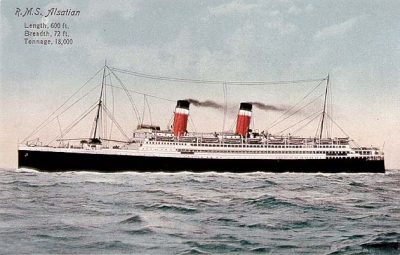
Alsatian had three complete steel decks in her hull, with a Shelter Deck, Bridge Deck, Promenade Deck and Boat Deck above, a total of seven decks. The fo’c’stle and bridge structure extended for 460 feet, and after dry docking at Govan, she sailed on three days of trials on 16th December 1913, during which she achieved twenty knots or one more knot than her service speed. Four steam turbines used steam from two boiler rooms and were constructed by the shipbuilder to deliver 21,400 shaft horsepower to her quadruple propellers.
Alsatian had two cowl topped red funnels with a white central band and black top, two tall masts, twenty lifeboats, and eight derricks to serve her holds of 281,000 cubic feet bale capacity and 7,600 tonnes of cargo, some of it refrigerated. She carried 110,468 cubic feet of bunker coal, but returned to her builder in 1924 to be converted to oil firing with bunker oil capacity of 3,600 tonnes, sufficient for a round voyage to Canada. She had the latest bridge navigation equipment with wireless direction finder fitted during World War I, submarine signalling apparatus and electric lightning throughout her cabins and public rooms.
Alsatian sailed on her maiden voyage from Liverpool to Halifax (NS) and St. John (NB) on 17th January 1914, and within a few months she shared the Liverpool service with her sister Calgarian as well as Victorian and Virginian, the first turbine powered liners on the North Atlantic. The Glasgow service to Canada was provided by the remainder of the Allan Line fleet. The thaw in May 1914 saw the Liverpool quartet transferred to the Montreal and Quebec terminals. In September 1914, Alsatian was requisitioned for service as an Armed Merchant Cruiser (AMC) in the Tenth Cruiser Squadron with eight 4.7 inch guns fitted, later re-armed with eight six inch guns and twin six pounder anti-aircraft guns. She took part on 8th September 1914 of the rescue of the naval crew from Oceanic of White Star Line, also serving as an AMC in the Tenth Cruiser Squadron, which went aground and was lost on Foula Island, Shetland.
Alsatian served with the Tenth Cruiser Squadron patrolling around the Shetland Islands as part of the Northern Patrol maintaining the blockade of Germany. She was the flagship of Rear Admiral Sir Dudley de Chair and later the flagship of Vice Admiral Sir Reginald Tupper. The Tenth Cruiser Squadron was disbanded during 1917, and she was one of sixteen Allan Line passenger and cargo ships transferred to Canadian Pacific Ocean Services Ltd. (CPOS) on 16th July 1917. The Allan Line staff, assets and goodwill of the company were transferred to the Canadian Pacific headquarters at 8, Waterloo Place in London. Allan Line had been founded in 1854 as the Montreal Ocean Steam Ship Company, and had contributed greatly to the development of Canada. Some of the grey painted liners and cargo ships continued on Government charter and did not transfer to CPOS until towards the end of the war. Alsatian did not decommission until December 1918, after a magnificent war record of having steamed 266,000 miles in Icelandic and Norwegian waters and had examined fifteen thousand ships and also escorted North Atlantic convoys. The Allan Line passenger and cargo ships were allowed to retain their names, but while reconditioning at her builders yard at Dalmuir, Alsatian was renamed Empress of France on 4th April 1919.
Empress of France began her commercial service for Canadian Pacific on 26th September 1919 with a sailing from Liverpool to Quebec and Montreal. She had a black hull, two buff funnels with black tops, a signal yard and second crowsnest on her foremast. She achieved a record Atlantic crossing from Liverpool to Quebec in 1920 of five days and 23 hours. In September 1921, CPOS was reorganised as Canadian Pacific Steamships Ltd. and the painting of the funnels became buff without the black tops, with a white line on the black hulls at the level of the second overall deck, and green boot topping. She was transferred to a Hamburg and Southampton and Le Havre service to the St. Lawrence in May 1922, and six months later she undertook a four month Round the World cruise for Clarks Tourist Agency of New York. This was repeated in winter 1923/24, but for the following winter Round the World voyages CPOS operated and marketed their own long distance cruises.
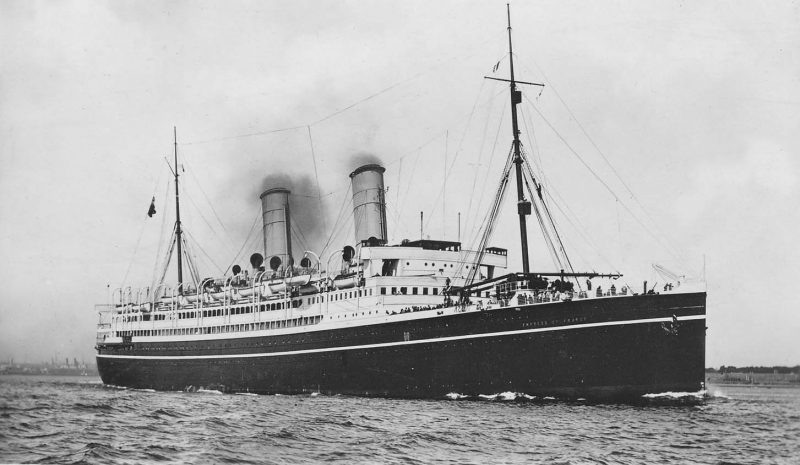
Many notable people and celebrities graced her sumptuous Georgian Dining Room including the Prince of Wales in 1923 on a voyage to Quebec, the Marquess of Anglesey, Harrison Watson (Chief Canadian Trade Commissioner in the U.K.), the Duke of Devonshire, Duchess of Devonshire and her daughter Lady Dorothy Cavendish accompanied by Capt. Harold Macmillan as aide-de-camp (later the Earl of Stockton and Prime Minister of the U.K. during 1957/63), Sir James McKechnie (Head of Vickers Engineering Group), Sir Herbert Holt (President of the Royal Bank of Canada), Lord Shaughnessy, Lt. Col. Sir Martin Archer-Shee, Sir Frederick Williams-Taylor, Sir Harold Boulton and Lady Boulton, and many others.
In October 1927, Empress of France dropped Hamburg as her European terminal, which became Southampton. She sailed from Southampton on 31st October 1928 for Vancouver and made five Transpacific round voyages to Japan with a white hull adorned by a yellow band. She returned to her Liverpool to Halifax (NS) and St. John (NB) service in early 1930, but made her last Transatlantic sailing from Liverpool on 2nd September 1931. On her return 27 days later, she was laid up on the Clyde for three years before she arrived at the Dalmuir fitting out basin, where she had been built, for scrapping on 24th November 1934. She had been sold for £35,000 to W. H. Arnott Young, who had purchased the land to the east of the fitting out basin at Dalmuir in 1934 for shipbreaking.
Four Canadian Pacific ‘Duchesses’
Canadian Pacific added four twin screw passenger liners to their fleet in 1928, known as the four ‘Duchesses’. The Duchess of Bedford was the first to be completed at the Clydebank yard of John Brown & Co. Ltd., and sailed on her maiden voyage on 1st June 1928 from Liverpool to Quebec and Montreal. After World War II, she was renamed Empress of France (2) in 1947. The other three ‘Duchesses’ were the Duchess of Atholl from the Beardmore yard, and the Duchess of Richmond and Duchess of York from the Clydebank yard of John Brown & Co. Ltd. They were designed by H. R. MacDonald of Canadian Pacific in collaboration with C. S. Douglas & Company of Glasgow, consulting naval architects. They were ‘Cabin Class’ liners to provide a high standard of comfort but falling short of the elaborate elegance and style of bigger Transatlantic liners. Their hull dimensions were overall length of 601.3 feet, length between perpendiculars of 580.0 feet, moulded beam of 75.0 feet, depth to Shelter Deck of 44.9 feet, loaded draft of 27.0 feet and gross tonnage of 20,020. The passenger complement was 580 in Cabin Class, 480 in Tourist Class, and 510 in Third Class, a total of 1,570 passengers including portable accommodation for 190 passengers on the Lower Deck forward, and with a crew of 510.
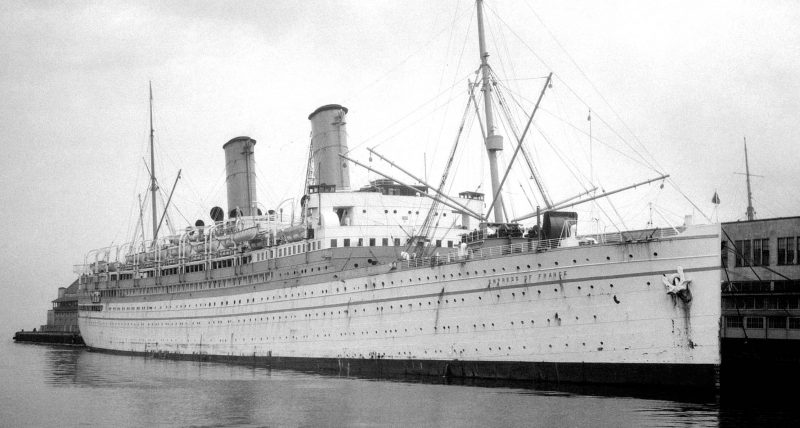
The Duchess of Richmond was launched on 18th June 1928, the Duchess of Atholl was launched on 13th July 1928, and the Duchess of York was launched on 28th September 1928 by H.R.H. Duchess of York and was the last of the quartet to enter service in March 1929. They had eight decks, namely from the top, Boat Deck, Promenade Deck, Bridge Deck (A), Shelter Deck (B), Upper Deck (C), Main Deck (D), Lower Deck (E) and Orlop Deck (F). Boat Deck had a length of 260.0 feet and Promenade Deck had a length of 332.0 feet. The main watertight subdivision was by eleven transverse bulkheads extending to the level of Upper Deck (C) with the exception of the collision bulkhead which was carried up to Shelter Deck (B). The cellular double bottom extended all the way from the fore peak to the after peak, and carried oil fuel, fresh water, feed water and water ballast. The fore peak, aft peak, and many hull compartments were formed by 188 hull frames with scantlings of up to eleven inches by 3.5 inches by 0.5 inches. They could carry 9,000 tons of cargo in seven holds, worked by fourteen derricks on two masts and three sets of posts. They carried 32 lifeboats with ten ‘nested’ sets, six boats carrying 46 persons, four boats carrying 86 passengers and two motor boats. The Captains Bridge had the navigating bridge and compass platform above, and there was also the aft docking bridge on a raised platform on Boat Deck.
Six Yarrow watertube boilers were fed from six oil fired furnaces, and the high pressure, high temperature steam was fed to two sets of Parsons steam turbines with single reduction gearing to 120 rpm, producing 20,000 shaft horsepower and a maximum of nineteen knots and a service speed of eighteen knots. The Chief Superintendent Engineer, John Johnson, of Canadian Pacific Steamship Ltd. had applied the economies of high pressure and high temperature steam in the design of the machinery, which marked a definite step forward in marine engineering. Bunker capacity was 2,725 tons of oil.
All four liners had only slight differences of minor importance, and the public rooms and interiors of the Duchess of Bedford are now described:-
Cabin Class Entrance Halls were situated ‘midships on Bridge Deck (A) and were panelled in mahogany and walnut, with an imposing stairway leading from Upper Deck (C) level to the large deckhouse on Boat Deck, while an electric lift was fitted in the central well of the stairway and extended to the same height. The well containing the lift was enclosed in a handsome wrought iron casing with glass panels.
Cabin Class Drawing Room on Promenade Deck led through to the Observation Room and was furnished with elegant small tables, elegant carver armchairs, comfortable settees and a large ornamental fireplace on one side. Long draped curtains of gold and apricot colours hung from fabric covered pelmets, deep recesses were panelled in sycamore, and three circular elegant ceiling lights lit this long room. Chairs and furniture were upholstered in apricot, gold and grey brocade and a beautiful grey carpet covered the floor. The Duchess of Richmond and the Duchess of York had blue curtains trimmed with gold, with apricot brocade hangings, chairs and furniture upholstered in grey, blue and apricot, and a blue and grey carpet.
Cabin Class Smoking Room on Promenade Deck had a series of double natural oak columns and pillars carved with a decorative motif at the top, elegant wall and ceiling decoration, recessed art forms and clock, and small tables each with four chairs, and comfortable armchairs and settees for relaxing at leisure. A teak parquetry floor was covered with Persian rugs and lit by bronze lanterns set into octagonal ceiling panels. The chairs and furniture were upholstered in tan velvet, leather and blue tapestry. The curtains of the Duchess of Richmond and the Duchess of York were marine green, and their furniture coverings were of marine green and nut coloured leather.
Cabin Class Staterooms on Boat Deck, Bridge Deck, Shelter Deck and Upper Decks had beds on either side of the cabin, hot and cold running water in the main part of the cabin and also in the en-suite bathroom. Electric fans, good carpets and draped curtains ensured comfortable sleeping quarters for two, three or four passengers.
Cabin Class Lounge on Promenade Deck was decorated in the ‘Empire’ style with silver grey sycamore woodwork with bronze gilt enrichments. The large dome above in the centre of the room was covered with an engraved glass laylight in an enriched bronze frame. The large, decorated windows had curtains of cerise and cream colour, while the handsome marble mantelpiece had gilt bronze mountings in the ‘Empire’ style and a large octagonal mirror formed one end of the room. Recessed panels of rich red cerise silk at the other end of the room formed the backdrop for the grand piano. Oak parquetry floor was ideal for dancing the night away after removing the large ‘Empire’ carpet and rugs, and harmonious furniture of mahogany with gilded mounts and upholstered in a brocade of cerise, cream and green colours made this room a delight.
Cabin Class Card Room and Writing Room on Promenade Deck was decorated in walnut with panels of paroba (a golden satinwood). A striking feature of the room was a mantelpiece with a marble surround with an inset tapestry panel. The windows were shuttered on the insides, the shutters being panelled with needlework. The writing tables and other furniture were of walnut with pleasing mixtures of biscuit, blue and nut brown colours. This room on the Duchess of Richmond and Duchess of York had a deep blue and gold colour scheme.
Cabin Class Long Gallery had walls of natural or bleached mahogany and was an attractive lounging space with comfortable chairs and settees upholstered in marine green and old gold and curtains of the same colour, with the floor covered in exquisite Persian rugs. This long room on the Duchess of Richmond and the Duchess of York was upholstered in Venetian red and fawn with curtains of the same colour.
Cabin Class Gymnasium and Children’s Room on Boat Deck had the latest rowing, riding, boxing, cycling and fencing equipment, with drawing boards, playground, rocking horse and swings in the children’s room.
Cabin Class Dining Room was ‘midships on ‘C’ Deck and very spacious with seating for 298 passengers with a spectacular central dome approximately eighteen feet above the floor and octagonal in shape with a richly carved electric pendant in the centre, and a musicians gallery at one end above the bar. The woodwork was in oak with gold enrichments, the walls being of red leather with bronze Spanish style studs. Red brocade curtains and tapestries divided by carved gilded mouldings, sidelights screened by sashed sliding windows of amber glass, chairs of natural oak and covered in leather, and gorgeous mirrors made this room a delight to eat in. The Duchess of Richmond and the Duchess of York had Dining Rooms with striped gold and red tapestries.
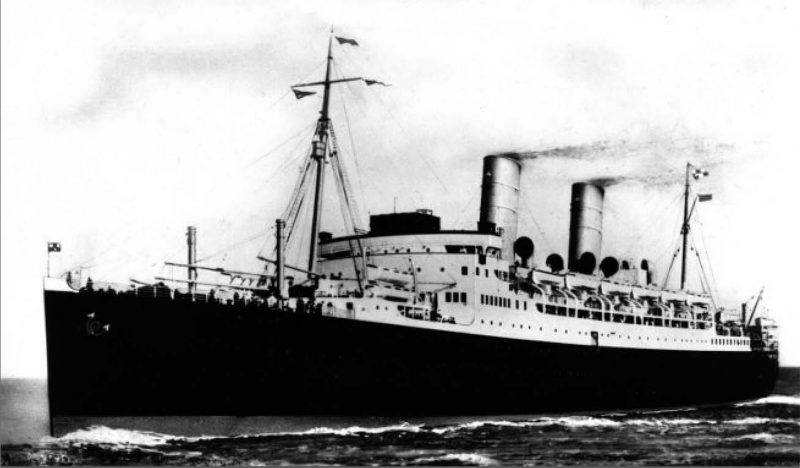
Tourist Class Lounge was aft on Bridge Deck (A) and was a large rectangular room with open promenade spaces outside the room. It was panelled with red birch, framed in teak, with a frieze of Macassar ebony. The numerous windows on both sides of the room had striped gold curtains, and there was a plethora of upholstered settees and wooden polished oak chairs, tables and settles. At the forward end of the room, there was a bar to port and a shop to starboard, and at the aft end was a stairway with a solid balustrade and teak latticed panels leading down to Shelter Deck (B). The mainmast passed through this room and was encased in an octagonal structure with alternate panels of cut crystal mirrors and wood. The ceiling was painted in light pastel colours and the floor was laid with green and fawn coloured tiles.
Tourist Class Dining Room was aft on Upper Deck (C) and had seating for up to 244 passengers at tables for two, four or six across the full width of the room. The walls were panelled in Oregon pine and the room was divided by teak pilasters enriched with colour. A brightly coloured frieze on both sides of the room extended over the side lights, which were screened by sliding windows of tinted glass and hung with curtains. The forward and aft ends of the room had large mirror panels, and in the centre were cut crystal mirrors to add dramatic effect to the dining experience. The furniture was of polished oak covered with red moquette, and the floor was covered in multi coloured tiles.
Tourist Class Entrance Hall was aft on Bridge Deck (A) and had walls panelled in oak and sycamore, with carved oak spindles forming decorated pilasters. Settees were fitted all around the sides of the room, upholstered with rose and blue moquette. The purple and red striped curtains at the windows, richly decorated coloured panels, rose and grey floor tiles, and writing tables in natural oak were welcoming features of the hall. The Tourist Class children’s room was immediately aft of the hall and was provided with games, drawing boards, playground, rocking horse, swings and roundabouts, and a dolls house. The majority of the Tourist Class cabins for two, three or four persons were on Shelter Deck (B) and Upper Deck (D).
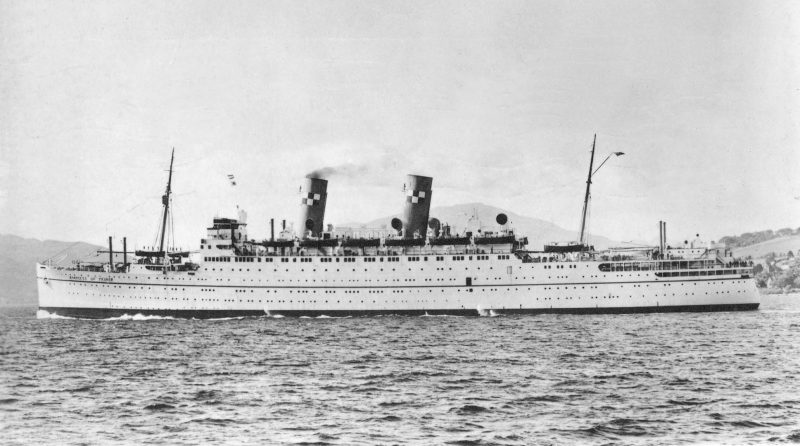
Third Class Lounge and Entrance Hall at the forward end of Bridge Deck (A) was panelled in light oak with sashed blue and cream curtains. Ample seating was provided by armchairs and settees upholstered in fawn and blue moquette. The foremast passed through this room and was boxed and cased in with oak, and cut glass mirrors reflected the lighting and greatly helped the decorative effect. The settees, chairs, writing tables were in oak standing on a blue tiled floor. The Third Class promenading space was outside this lounge.
Third Class Smoking Room at the forward end of Shelter Deck (B) had walls of red birch panels framed in teak, with comfortable settees around the sides of the room upholstered in brown and gold moquette, and chairs in natural oak wood. The sidelights were recessed and decorated with orange curtains, the cream ceiling was panelled, and the floor was covered with grey tiles.
Third Class Dining Room was ‘midships on Main Deck (D) with seating for between 207 and 253 passengers at tables for four or six persons. The walls were panelled in red and white birch framed in teak, with mirrors between the panels, and small coloured pilasters. The sidelights were screened by sliding sashed windows, glazed with opaque glass, and with orange curtains. The ceiling was panelled in light pastel colours, and the floor was covered in red and grey tiles, with oak furniture covered with blue upholstery. Aft of this dining room were the main pantries for frozen and chilled meat, butter, cheese and eggs, fruit, potatoes and vegetables, flour, groceries, and cold stores. Many Third Class cabins were forward and aft of this Dining Room, the remainder were on Lower Deck (E) and Upper Deck (C).
Career Of The Duchess Of Bedford
She had been launched at Clydebank on 24th January 1928 by Mrs. Stanley Baldwin, wife of the Prime Minister, and sailed on her maiden voyage from Liverpool to Quebec and Montreal on 1st June 1928.
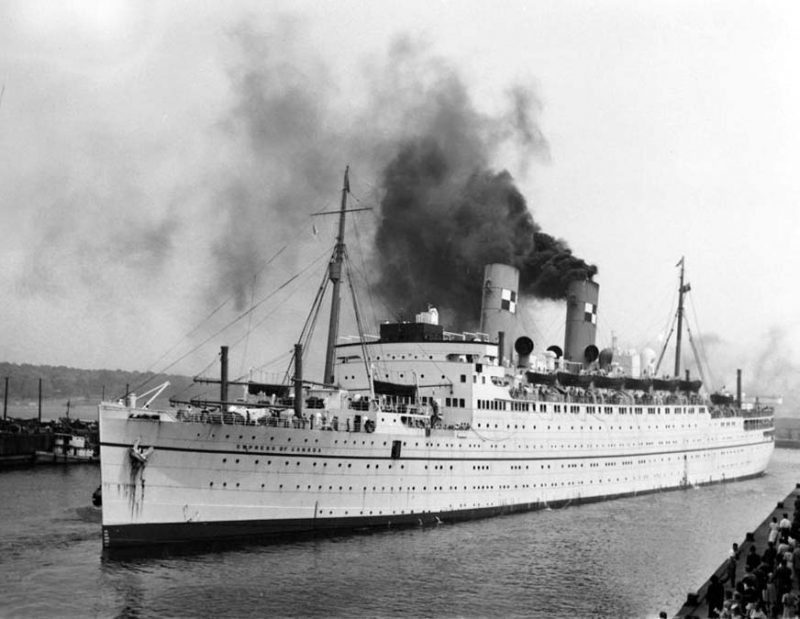

She was followed on the same service by her sisters Duchess of Atholl and Duchess of York, but the fourth sister, Duchess of Richmond, sailed on a 42 day cruise to the Canary Islands and to British and French West Africa on 26th January 1929. The Duchess of Bedford was chartered by Furness, Withy & Co. Ltd. for four voyages as a running mate in February 1933 from New York to Bermuda for the new Monarch of Bermuda, pending the arrival of her sister Queen of Bermuda. She also went cruising in the winter slack season, completing a total of seventeen long cruises up to the outbreak of war in September 1939, thirteen of these being sixteen day cruises from New York to the West Indies. The other four cruises were from Liverpool, and there were also regular nine day cruises from Montreal to New York and return.
The Duchess of Bedford was requisitioned at Liverpool on 29th August 1939 as a troopship and sailed the following day for Bombay. During the war, she was present at the North African landings of Operation Torch, and the Sicilian and Italian landings, being the first transport in at Salerno.
She carried an enormous total of 187,327 British, Canadian, American and Indian troops during the war, and steamed 435,877 miles. In August 1942, she engaged a U-boat in a fierce gun battle in the North Atlantic and was credited with the sinking, although none were identified. During 1943, she trooped from West Africa to Burma with colonial regiments. She was a lucky ship as two of her sisters, the Duchess of Atholl and the Duchess of York, became war losses. At the end of the war, she carried liberated Russian prisoners to Odessa, and returned with Allied prisoners of war. She continued trooping after the end of the war until decommissioned at Liverpool on 2nd March 1947. She sailed the following day for an extensive overhaul and conversion to a two class ship at the Fairfield yard at Govan.
Career Of The Empress Of France (2)
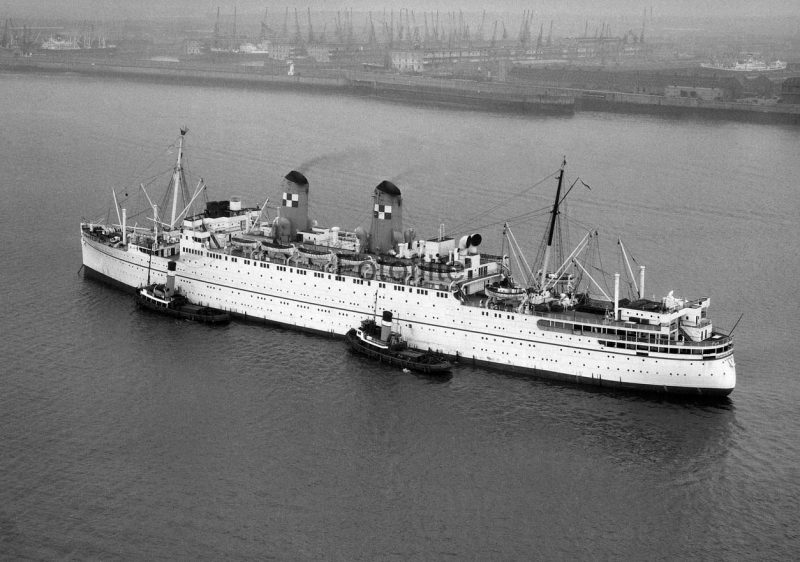
An eighteen month overhaul at Govan revitalised the Duchess of Bedford, during which she was upgraded from a ‘Duchess’ to an ‘Empress’, renamed Empress of France (2) in October 1947. The remaining sister, the Duchess of Richmond, was similarly upgraded to become the Empress of Canada. They were given a white hull with a green line and green boot topping, buff funnels with the red and white chequerboard houseflag of Canadian Pacific. Empress of France (2) now carried 400 passengers in First Class and 482 passengers in Tourist Class with some accommodation interchangeable. The public rooms were completely redecorated, with a new ‘Empress Room’ built to act as both cinema and ballroom for her upgraded status. The Promenade Deck was covered in for the full length of the Boat Deck above, and fitted with tall rectangular windows. Fewer lifeboats were now needed and the inner ‘nested boats’ were removed.
The upgraded Empress of France (2) made her first post-war sailing on 1st September 1948 from Liverpool to Quebec and Montreal, and ran with Empress of Canada and also ran with the Empress of Scotland 26,032/30 (ex Empress of Japan) from 1950. The three ship North Atlantic service, each ship with a three week schedule, was broken on 25th January 1953 when the Empress of Canada caught fire and capsized at her berth in the Gladstone Dock at Liverpool. After righting, she was fit only for scrapping and left in tow of Zwarte Zee from the Mersey on 1st September 1954 for demolition at La Spezia. The French Line De Grasse 19,379/24 was hurriedly acquired as a replacement to maintain the three ship service as Empress of Australia, and she served until the end of the 1955 season. Two new sisters were built on the Tyne and the Clyde as Empress of England and Empress of Britain in 1956/57, replacing both the Empress of Australia and the Empress of Scotland, which was withdrawn at the end of the 1957 season and sold to German owners and rebuilt as the Hanseatic. The three ship service was then maintained by Empress of France (2), Empress of Britain and Empress of England, with Empress of France (2) given ‘pepper pot’ funnels in 1958. Empress of France (2) underwent her last special survey at Liverpool at that time when thirty years old.
Empress of France (2) made her last Transatlantic voyage from Liverpool in late November 1960 with First Class passengers and five hundred Canadian troops occupying the Tourist Class accommodation for their return from duty in Germany. She arrived back at Liverpool on 9th December 1960 and was put up for sale, her buyer being the British scrap steel industry, and she was allocated to the John Cashmore and Sons yard at Newport in South Wales, where she arrived in the final days of December 1960. The magnificent Empress Bar from her Empress Room was saved from demolition and is now in the Barry Hotel a few miles away in Barry in South Wales. The Duchess of Bedford had been beautifully upgraded to serve as a Canadian Pacific ‘Empress’ in 1947 to continue her long and glorious career of thirty two years.
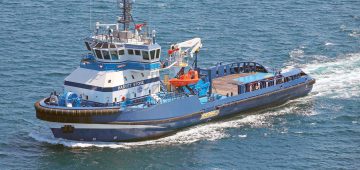




Comments
Sorry, comments are closed for this item